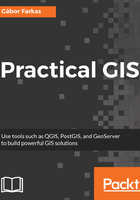
Accessing vector data
Now that you've learned the basics of raster data, let's examine vector data. This is the other fundamental data type which is used in GIS. Let's get some vector data at the top of that srtm layer. From the Browser Panel, we open up the administrative boundaries layer (the one with the shp extension) containing our study area, and the waterways and traffic layers from the OpenStreetMap data. We can also use the Add Vector Layer button from the side toolbar:

Now there are three vector layers with three different icons and representation types on our canvas. These are the three main vector types we can work with:
- Points: Points are used to represent single punctual occurrences of phenomena
- Lines: Lines are used to show linear features and boundaries
- Polygons: Polygons are used to delimit areas
If we zoom around, we can see that unlike the raster layer, these layers do not pixelate. They remain as sharp as on lower zoom levels no matter how far we zoom in. Furthermore, if we use the Identify Features tool and click on a feature, it gets selected. We can see with this that our vector layers consist of arbitrary numbers of points, lines, and irregular shapes:
